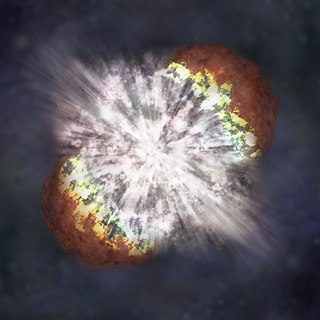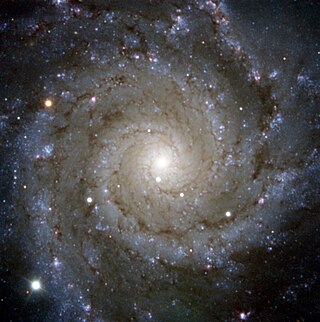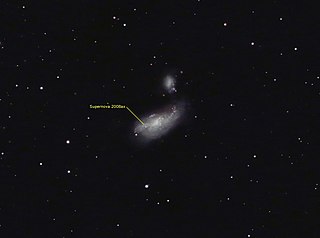
A supernova is a powerful and luminous explosion of a star. A supernova occurs during the last evolutionary stages of a massive star or when a white dwarf is triggered into runaway nuclear fusion. The original object, called the progenitor, either collapses to a neutron star or black hole, or is completely destroyed to form a diffuse nebula. The peak optical luminosity of a supernova can be comparable to that of an entire galaxy before fading over several weeks or months.

A super-luminous supernova is a type of stellar explosion with a luminosity 10 or more times higher than that of standard supernovae. Like supernovae, SLSNe seem to be produced by several mechanisms, which is readily revealed by their light-curves and spectra. There are multiple models for what conditions may produce an SLSN, including core collapse in particularly massive stars, millisecond magnetars, interaction with circumstellar material, or pair-instability supernovae.

Messier 74 is a large spiral galaxy in the equatorial constellation Pisces. It is about 32 million light-years away from Earth. The galaxy contains two clearly defined spiral arms and is therefore used as an archetypal example of a grand design spiral galaxy. The galaxy's low surface brightness makes it the most difficult Messier object for amateur astronomers to observe. Its relatively large angular size and the galaxy's face-on orientation make it an ideal object for professional astronomers who want to study spiral arm structure and spiral density waves. It is estimated that M74 hosts about 100 billion stars.

Messier 108 is a barred spiral galaxy about 28 million light-years away from Earth in the northern constellation Ursa Major. It was discovered by Pierre Méchain in 1781 or 1782. From the Earth, this galaxy is seen almost edge-on.

NGC 6946, sometimes referred to as the Fireworks Galaxy, is a face-on intermediate spiral galaxy with a small bright nucleus, whose location in the sky straddles the boundary between the northern constellations of Cepheus and Cygnus. Its distance from Earth is about 25.2 million light-years or 7.72 megaparsecs, similar to the distance of M101 in the constellation Ursa Major. Both were once considered to be part of the Local Group, but are now known to be among the dozen bright spiral galaxies near the Milky Way but beyond the confines of the Local Group. NGC 6946 lies within the Virgo Supercluster.

SN 2005df was a Type Ia supernova in the barred spiral galaxy NGC 1559, which is located in the southern constellation of Reticulum. The event was discovered in Australia by Robert Evans on the early morning of August 5, 2005 with a 13.8 magnitude, and was confirmed by A. Gilmore on August 6. The supernova was classified as Type Ia by M. Salvo and associates. It was positioned at an offset of 15.0″ east and 40.0″ north of the galaxy's nucleus, reaching a maximum brightness of 12.3 on August 18. The supernova luminosity appeared unreddened by dust from its host galaxy.

NGC 7793 is a flocculent spiral galaxy in the southern constellation of Sculptor. It was discovered in 1826 by Scottish astronomer James Dunlop. The galaxy is located at a distance of 12.2 million light years and is receding with a heliocentric radial velocity of 227 km/s. NGC 7793 is one of the five brightest galaxies within the Sculptor Group.

A Type Ia supernova is a type of supernova that occurs in binary systems in which one of the stars is a white dwarf. The other star can be anything from a giant star to an even smaller white dwarf.

SN 1994D was a Type Ia supernova event in the outskirts of galaxy NGC 4526. It was offset by 9.0″ west and 7.8″ south of the galaxy center and positioned near a prominent dust lane. It was caused by the explosion of a white dwarf star composed of carbon and oxygen. This event was discovered on March 7, 1994 by R. R. Treffers and associates using the automated 30-inch telescope at Leuschner Observatory. It reached peak visual brightness two weeks later on March 22. Modelling of the light curve indicates the explosion would have been visible around March 3-4. A possible detection of helium in the spectrum was made by W. P. S. Meikle and associates in 1996. A mass of 0.014 to 0.03 M☉ in helium would be needed to produce this feature.

Type Ib and Type Ic supernovae are categories of supernovae that are caused by the stellar core collapse of massive stars. These stars have shed or been stripped of their outer envelope of hydrogen, and, when compared to the spectrum of Type Ia supernovae, they lack the absorption line of silicon. Compared to Type Ib, Type Ic supernovae are hypothesized to have lost more of their initial envelope, including most of their helium. The two types are usually referred to as stripped core-collapse supernovae.
SN 1999ec was a type Ib supernova that was discovered in the interacting galaxy NGC 2207 on October 2, 1999. It was found on images taken with the Katzman Automatic Imaging Telescope at the Lick Observatory. The progenitor is estimated to have had 38 times the mass of the Sun and was 5.34 million years old at the time of the outburst.

SN 2008ax was a helium-rich type Ib core-collapse supernova in the interacting galaxy NGC 4490. It was independently discovered on 3 March 2008 by LOSS and 4 March by Koichi Itagaki. The site had been monitored six hours before discovery, thus constraining the time of the explosion breakout. It was the third-brightest supernova of 2008. The brightness in the B-band peaked about 20 days after the explosion. X-ray emissions were detected from the event, which are most likely the result of shock heating from the supernova ejecta and circumstellar material.

NGC 7424 is a barred spiral galaxy located 37.5 million light-years away in the southern constellation Grus. Its size makes it similar to our own galaxy, the Milky Way. It is called a "grand design" galaxy because of its well defined spiral arms. Two supernovae and two ultraluminous X-ray sources have been discovered in NGC 7424.

SN 1994I is a Type Ic supernova discovered on April 2, 1994 in the Whirlpool Galaxy by amateur astronomers Tim Puckett and Jerry Armstrong of the Atlanta Astronomy Club. Type Ic supernova are a rare type of supernova that result from the explosion of a very massive star that has shed its outer layers of hydrogen and helium. The explosion results in a highly luminous burst of radiation that then dims over the course of weeks or months. SN 1994I was a relatively nearby supernova, and provided an important addition to the then small collection of known Type Ic supernova. Very early images were captured of SN 1994I, as two high school students in Oil City, Pennsylvania serendipitously took images of the Whirlpool Galaxy using the 30-inch telescope at Leuschner Observatory on March 31, 1994, which included SN 1994I just after it began to brighten.
SN 1917A is a supernova event in the Fireworks Galaxy, positioned 37″ west and 105″ south of the galactic core. Discovered by American optician George Willis Ritchey on 19 July 1917, it reached a peak visual magnitude of 13.6. Based on a poor quality photographic spectrum taken at least a month after peak light by F. G. Pease and Ritchey, it was identified as a type II core-collapse supernova.

NGC 2397 is a flocculent spiral galaxy located in the southern Volans constellation, about one degree to the SSE of Delta Volantis. English astronomer John Herschel discovered the galaxy on February 21, 1835. It is located at a distance of approximately 69 million light years from the Sun, and is a member of the small NGC 2442 group that includes NGC 2434.

NGC 3938 is an unbarred spiral galaxy in the Ursa Major constellation. It was discovered on 6 February 1788 by William Herschel. It is one of the brightest spiral galaxies in the Ursa Major South galaxy group and is roughly 67,000 light years in diameter. It is approximately 43 million light years away from Earth. NGC 3938 is classified as type Sc under the Hubble sequence, a loosely wound spiral galaxy with a smaller and dimmer bulge. The spiral arms of the galaxy contain many areas of ionized atomic hydrogen gas, more so towards the center.

NGC 6384 is an intermediate barred spiral galaxy located about 77 million light-years away in the northern part of the constellation Ophiuchus. It has a morphological classification of SAB(r)bc, indicating that it is a weakly barred galaxy (SAB) with an inner ring structure (r) orbiting the bar, and moderate to loosely wound spiral arms (bc). The galaxy is inclined by an angle of 47° to the line of sight, along a position angle of 40°. The estimated mass of the stars in this galaxy is 105 billion times the mass of the Sun.

A hypernova is a very energetic supernova thought to result from an extreme core-collapse scenario. In this case, a massive star collapses to form a rotating black hole emitting twin astrophysical jets and surrounded by an accretion disk. It is a type of stellar explosion that ejects material with an unusually high kinetic energy, an order of magnitude higher than most supernovae, with a luminosity at least 10 times greater. They usually appear similar to a type Ic supernova, but with unusually broad spectral lines indicating an extremely high expansion velocity. Hypernovae are one of the mechanisms for producing long gamma ray bursts (GRBs), which range from 2 seconds to over a minute in duration. They have also been referred to as superluminous supernovae, though that classification also includes other types of extremely luminous stellar explosions that have different origins.

SN 2020oi was a supernova event in the grand design spiral galaxy known as Messier 100, or NGC 4321. It was discovered January 7, 2020 at an apparent magnitude of 17.28 by F. Forster and associates using the Zwicky Transient Facility. The position places it ~4.67″ north of the galactic nucleus. The supernova was not detected on an observation made three days before the discovery, and thus it must have begun during that brief period. The light curve peaked around January 13–18, depending on the wavelength, then declined rapidly over a period of 25 days before flattening into a more gradual decline. Observations of the spectrum made with the SOAR telescope showed this to be a type Ic supernova, with the progenitor being a massive star that had its outer envelope stripped. The initial velocity of the expanding photosphere was ~15,000 km/s.
















